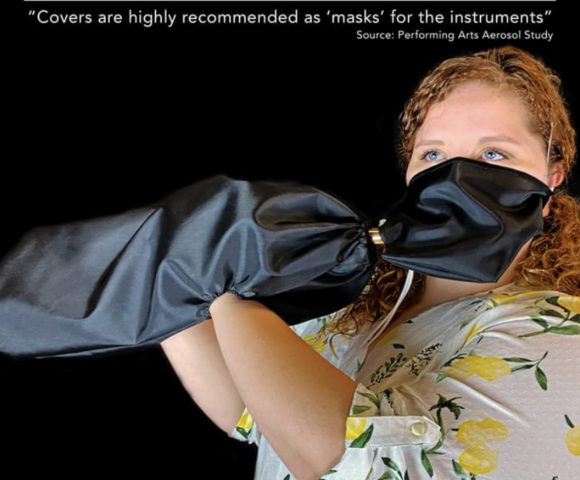Flutes in Quarantine: Pandemic Safety Part 2
The title “Flutes in Quarantine” is a bit cheeky. Now, after more than five months after the world was shut down for COVID-19, we laugh to keep from crying. It’s a strange, almost dystopian world.
One year ago, I could not have imagined that I would be sending my kids to school wearing masks, that “social distancing” would be the norm, and that science would be political. But here we are.
For some background, please check out the blog articles “Pandemic Flute Safety, Part 1,” “A New Normal: Thoughts on COVID-19 Pandemic,” “Virtual Music: Teaching Lessons Online: The Good,” and “Virtual Music: Teaching Lessons Online: The Difficult“
Real or Fake?

When I saw this picture on Facebook, I laughed out loud. Many people in my sphere are talking about how to play the flute safely during the pandemic. From band directors to private flute teachers to parents, we are all trying to figure out how to stay safe and make music. Should flutes be kept in quarantine or is it safe to come out now?
This picture must be a joke, right? Like the friend on Facebook who sarcastically suggested that flutists put trash bags over our heads, this contraption had to be fake. Except it isn’t.

For $39.99, you can have your very own flute instrument cover in white or black. While you visit the website, be sure to check out the covers for other instruments, including the glamorous, gloved french horn…

…and bassoon.

Thanks for that disclaimer, by the way. I was concerned about the model’s safety with a reed. 😂
What We Know… And What We Don’t Know
Should we put all the flutes in quarantine?
The most frequently cited study by band directors, “Performing Arts Aerosol Study,” is incomplete and has not been peer-reviewed. Nonetheless, I see it sited as scientific evidence everywhere.
Other studies, which are expected to be more robust, are currently underway.
How is the virus transmitted?
The Time Magazine article “COVID-19 Is Transmitted Through Aerosols. We Have Enough Evidence, Now It Is Time to Act” was published on August 25. In the article, the author argues that we are overdue for a change in our thinking about the virus. Early in the pandemic, the public was urged to wash hands and sanitize surfaces. Face masks were only to be used by medical professionals.
However, now we know that it is unlikely that you can get sick from the virus by touching infected surfaces. It’s always a good idea to wash your hands and keep surfaces clean because contaminated objects can harbor lots of bad bacteria, viruses, and fungi.
Droplets vs. Aerosols
We also need to understand the difference between droplets and aerosols. Droplets are larger than aerosols. When you use a spray to clean windows, you are blowing droplets on the glass. The droplets are relatively heavy and if you miss the window, most of the droplets end up on the ground a few feet away. If droplets are the main method of spread, keeping a distance of 6′ makes a lot of sense since most droplets cannot travel that far. A sneeze or cough can produce a lot of droplets. Putting physical distance between you and a droplet-producer is good advice.
However, aerosols are much, much smaller than droplets. Aerosols are created anytime someone talks or even breathes. These tiny droplets don’t just drop to the ground. Because they are small and light, they can get scooped up by air currents. Air conditioners do a particularly good job of spreading aerosols. We also know that some people are “super-spreaders” of aerosols. Masks offer protection against aerosols, especially if everyone is wearing them.
Early in the pandemic, we learned about a sick diner at a restaurant in China. That person ended up infecting people who were seated 3 meters away. Droplets were circulated by the HVAC system.
Some buildings are looking at how HVAC systems can be retrofitted to prevent the spread of COVID-19. However, HEPA filters cannot always be used in old systems. More work clearly needs to be done in this area.
What Does This Mean for Flutes in Quarantine?
Until we have better studies about the spread of aerosols by flute players, it is my opinion that it is not safe to play the flute indoors around other people. From what I understand about the production of sound on the flute, we are potentially super-spreaders.
Even though we all want to return to normal as soon as possible, we need to wait until we have good science. I’ll keep the blog updated as we learn more.
Happy Practicing!
The good news is that practicing at home is perfectly safe and healthy. In fact, playing an instrument is a good stress reliever, and that’s something we all need right now. Virtual lessons are wonderful. Keep practicing and when it’s safe to play together again, we will all be ready!

No comments.